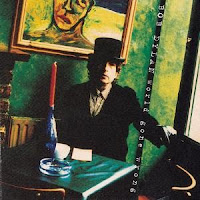 1. “Just like Tom Thumb’s Blues” (1966). My French has seen better days, but I’m pretty sure “Rue Morgue Avenue” means “Morque Street Avenue” in English. And that minor verbal infelicity may be all that’s wrong with the first of Dylan’s two 1966 “Just like” songs. Besides, it’s a funny line anyway, leading as it does into a warning about women apparently made hungry by the “airs” a man might put on. The Juarez women not on the street aren’t much better: Sweet Melinda isn’t known as the “goddess of gloom” for nothing. She’ll even “steal your voice” if you “go to her [room] to soon,” even if you only went because she invited you and you thought, “Why not? She speaks good English” (and you were only early because. as a foreigner, you wanted to make a good impression.) And, of course, the last line, coming as it does after what’s essentially a series of thought dreams that Dylan would’ve rather left unseen (by himself), packs a punch. Not-bad cover version: Bill Kirchen’s on his 2001 album Tied to the Wheel. Not-bad Juarez fun fact: It’s located in the Mexican state of Chihuahua.
1. “Just like Tom Thumb’s Blues” (1966). My French has seen better days, but I’m pretty sure “Rue Morgue Avenue” means “Morque Street Avenue” in English. And that minor verbal infelicity may be all that’s wrong with the first of Dylan’s two 1966 “Just like” songs. Besides, it’s a funny line anyway, leading as it does into a warning about women apparently made hungry by the “airs” a man might put on. The Juarez women not on the street aren’t much better: Sweet Melinda isn’t known as the “goddess of gloom” for nothing. She’ll even “steal your voice” if you “go to her [room] to soon,” even if you only went because she invited you and you thought, “Why not? She speaks good English” (and you were only early because. as a foreigner, you wanted to make a good impression.) And, of course, the last line, coming as it does after what’s essentially a series of thought dreams that Dylan would’ve rather left unseen (by himself), packs a punch. Not-bad cover version: Bill Kirchen’s on his 2001 album Tied to the Wheel. Not-bad Juarez fun fact: It’s located in the Mexican state of Chihuahua. 2. “Jokerman” (1983). The Presbyterian pastor Don Williams argued at some length in his 1985 book Bob Dylan: The Man, the Music, the Message that the subject of “Jokerman” is Christ, and he doesn’t do a bad job, but I’m not convinced. (There doesn’t seem anything particularly Messianic about having your face licked by a small dog.) And clearly the director of the video, who illustrated the verses with a wide variety of paintings and sculpture, didn’t adhere to a monadic interpretation either. Quite possibly Dylan didn’t even have a specific entity in mind: All he told Kurt Loder about the song in his 1984 Rolling Stone interview was that it “was sort of inspired by these [Caribbean] spirits they call jumbis.” (That’s “moko jumbies” to you Wikipedia users.) Of this much I and I am certain: The difficulties he encountered on his (also 1984) punk performance of this song on the Letterman show still makes for seriously fun times (and perhaps the wildest live harmonica solo of Dylan’s career).
2. “Jokerman” (1983). The Presbyterian pastor Don Williams argued at some length in his 1985 book Bob Dylan: The Man, the Music, the Message that the subject of “Jokerman” is Christ, and he doesn’t do a bad job, but I’m not convinced. (There doesn’t seem anything particularly Messianic about having your face licked by a small dog.) And clearly the director of the video, who illustrated the verses with a wide variety of paintings and sculpture, didn’t adhere to a monadic interpretation either. Quite possibly Dylan didn’t even have a specific entity in mind: All he told Kurt Loder about the song in his 1984 Rolling Stone interview was that it “was sort of inspired by these [Caribbean] spirits they call jumbis.” (That’s “moko jumbies” to you Wikipedia users.) Of this much I and I am certain: The difficulties he encountered on his (also 1984) punk performance of this song on the Letterman show still makes for seriously fun times (and perhaps the wildest live harmonica solo of Dylan’s career). 3. “Just like a Woman” (1966). I knew a fetching little waif in college who hated this song because she thought the refrain was overbearingly sexist, patronizing--you know the categories. And she might have been right. But you can also hear the refrain as nothing more than an attempt on the part of the singer to differentiate between what’s “womanly” and “girlish” in his “Baby.” (At least Dylan didn’t sing, “She makes love just like a lady”!) Anyway the point of the song isn't "woman" or "girl" but the last line of the bridge leading into the last verse. Dylan dug the chick, but he didn’t “fit” into her world (I’m thinking that her friends--especially the hot ones--were tolerable but that the in-laws were positively 4th Street), and now he wants to save face when they inevitably run into each other at Andy Warhol’s Factory. The last thing a rising young Voice of a Generation needs is people knowing he’d been dumped by someone whom it really would’ve been to his advantage to have been adored by.
3. “Just like a Woman” (1966). I knew a fetching little waif in college who hated this song because she thought the refrain was overbearingly sexist, patronizing--you know the categories. And she might have been right. But you can also hear the refrain as nothing more than an attempt on the part of the singer to differentiate between what’s “womanly” and “girlish” in his “Baby.” (At least Dylan didn’t sing, “She makes love just like a lady”!) Anyway the point of the song isn't "woman" or "girl" but the last line of the bridge leading into the last verse. Dylan dug the chick, but he didn’t “fit” into her world (I’m thinking that her friends--especially the hot ones--were tolerable but that the in-laws were positively 4th Street), and now he wants to save face when they inevitably run into each other at Andy Warhol’s Factory. The last thing a rising young Voice of a Generation needs is people knowing he’d been dumped by someone whom it really would’ve been to his advantage to have been adored by. 4. “Jack-A-Roe” (1993). You don’t have to have a Ph.D. in Ye Olde Ballads to love the story: Girl meets boy, girl’s rich father disapproves of less-than-rich boy, boy goes off on a cannon-ball-firing (and receiving) warship, girl dresses like a male soldier and joins boy in battle, girl eventually saves boy's life. Neither do you have to have made straight A’s in love to appreciate the fact that the whole story turns out to be a marriage proposal.
4. “Jack-A-Roe” (1993). You don’t have to have a Ph.D. in Ye Olde Ballads to love the story: Girl meets boy, girl’s rich father disapproves of less-than-rich boy, boy goes off on a cannon-ball-firing (and receiving) warship, girl dresses like a male soldier and joins boy in battle, girl eventually saves boy's life. Neither do you have to have made straight A’s in love to appreciate the fact that the whole story turns out to be a marriage proposal. 5. “John Brown” (1963). Until a better Dylan version of this song than the one on MTV Unplugged surfaces, the Staple Singers will own this most viscerally anti-war of Dylan’s anti-war songs. Actually, as anti-war songs go, it’s not all that visceral. Anyone who, like John Brown (I'm thinking it's an alias) signs up for combat duty has to know there’s a better-than-remote possibility that he’ll end up with his face shot up and his hand blown off. Brown also seems to have been surprised that his enemy’s face looked just like his. Whom did he think he was going to war against--wombats? Of course human faces resemble each other! Frankly, neither Brown nor his mother, who is also surprised that war is hell, seem especially bright. So maybe Brown's being taken out of the action (not only of the war but also of ever making it as a Soul Train dancer) is just natural selection at work. “Gee,” you might be saying, “you really don’t like this song.” Fair enough. But I really don’t like “Joey,” “John Wesley Harding” (more examples of Dylan’s ridiculously romanticized “honest” livers outside the law), “Jolene,” and “Jet Pilot” at least as much. (“Jim Jones” ain’t bad.)
5. “John Brown” (1963). Until a better Dylan version of this song than the one on MTV Unplugged surfaces, the Staple Singers will own this most viscerally anti-war of Dylan’s anti-war songs. Actually, as anti-war songs go, it’s not all that visceral. Anyone who, like John Brown (I'm thinking it's an alias) signs up for combat duty has to know there’s a better-than-remote possibility that he’ll end up with his face shot up and his hand blown off. Brown also seems to have been surprised that his enemy’s face looked just like his. Whom did he think he was going to war against--wombats? Of course human faces resemble each other! Frankly, neither Brown nor his mother, who is also surprised that war is hell, seem especially bright. So maybe Brown's being taken out of the action (not only of the war but also of ever making it as a Soul Train dancer) is just natural selection at work. “Gee,” you might be saying, “you really don’t like this song.” Fair enough. But I really don’t like “Joey,” “John Wesley Harding” (more examples of Dylan’s ridiculously romanticized “honest” livers outside the law), “Jolene,” and “Jet Pilot” at least as much. (“Jim Jones” ain’t bad.)(Bob Dylan's Top-Five Songs Beginning with "I": http://arsenioorteza.blogspot.com/2010/08/bob-dylans-top-five-songs-beginning_05.html)

Good list, but I would replace Jack-A-Roe with John Wesley Harding to keep it all Dylan compositions.
ReplyDeleteAnother legitimate point. But I think once a singer records a song, it becomes one of "his" songs (as in "Elvis Presley's 'Suspicious Minds'"). And I really don't care for the songs in which Dylan rehabilitates murderers (John Wesley Hardin in this case) by white-washing them into folk heroes.
ReplyDeleteJohn Brown for me great song.
ReplyDeleteI think John Brown was one of those songs he recorded as Blind Boy Grunt for Broadside. There is a boot of it out there and I probably have it. Who can track of all their Bob Dylan bootlegs? But the one I'm thinking of was real good because it had that drive a lot of his early acoustic music had..
ReplyDelete